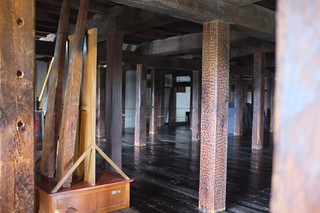Day 5: Matsumoto
Matsumoto is an ancient castle town. The keep of the castle, the current incarnation of which was built in 1593, is what remains today. What distinguishes Matsumoto Castle is that this is still largely the original construction. Most castles in Japan have been reconstructed more recently. Matsumoto Castle has survived intact for 400 years.
It’s about a 15-minute walk to the castle from the train station.
There’s no mistaking it when you find it.
You can go into the castle and walk around all of the floors. They also have some displays inside of (really) old firearms that would have been used at various times in the castle’s history.
The stairs were very steep and got steeper as you got to the upper floors. This was a defense mechanism to slow down invaders that got into the castle.
Yep, that’s me at Matsumoto Castle.
Adjacent to the castle is the Matsumoto City Museum, which is small but has some neat old artifacts and some history about the city.
This pottery is labeled as being from 100 B.C.–A.D. 100. That’s some really old pottery.
And this is a couple thousand years older than that, being labeled 3000–2000 B.C.
More modern (early 20th century, I think) water hand-pump fire extinguisher and some nasty looking things labeled “police equipment.” Something tells me you didn’t want to have a run-in with the law back then.
And an early rocket ship? No idea….
Past the castle is another interesting cultural asset, a former elementary school named Kaichi. Built in 1876, it’s the oldest example in Japan of a school building influenced by western architecture.
It’s a neat old building, and as you walked through the classrooms there were various exhibits and signs talking about the transition from the old feudal system to compulsory public education at the beginning of the 20th century during the Meiji Restoration.
These carved doors are some of the originals from when the school was built. My school certainly didn’t have anything as ornate.
Last stop in Matsumoto was the Matsumoto Timepiece Museum. As a fan of timepieces, I had to check it out. The museum’s entrance on the street corner houses the largest pendulum clock in Japan. They have a good collection of late 19th/early 20th century timepieces from Europe, but up on the second floor there were a bunch of old Japanese clock designs that were certainly different from their European counterparts.
Back toward the station I grabbed some food.
Now I’m on the Shinano 18 (which happens to be the same train I came to Matsumoto on, I’m just hopping on it 24 hours later to continue down the line) to Nagoya, where I have 16 minutes to find the Shinkansen Hikari 521 to ride to Osaka at warp speed.
Matsumoto struck me as a neat city. The central tourist attraction is the castle, of course, but the area for several kilometers around the castle is filled with museums, galleries, significant cultural sites like the Kaichi school, etc.






































